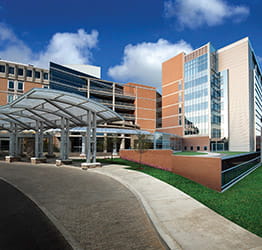What Is Cervical Discectomy with Fusion Surgery?
Cervical discectomy with fusion surgery is a common, minimally invasive spine surgery procedure. The surgeon removes a herniated or ruptured disc in your neck, which can relieve pressure on the spinal cord or nerve root. This pressure can cause pain, weakness, numbness, and tingling in your upper body, arms, hands, or fingers.
Surgeons will usually combine a cervical discectomy with a fusion procedure. Fusion joins two or more neck bones together to stabilize your spine.
Types of cervical discectomy with fusion surgery
There are two main types of cervical discectomy with fusion surgery, including:
Posterior cervical discectomy with fusion
A surgeon does a posterior cervical discectomy with fusion (PCDF) procedure through an incision in the back of your neck. They will remove the damaged disc and place a bone graft and other devices to permanently fuse or join your neck bones together over time. The fused bones help stabilize your spine.
Anterior cervical discectomy with fusion
Anterior cervical discectomy with fusion (ACDF) is the standard surgical treatment to remove damaged cervical discs in the neck. During an ACDF procedure, your surgeon will make a small incision in the front of your neck. They then remove the diseased disc and place a bone graft and another device. This fuses the bones in your neck together over time, stabilizing the spine.
ACDF is a less complicated procedure than PCDF. It provides access to the entire upper portion of your spine and typically causes less pain and a faster recovery after surgery than other approaches.
UPMC spine surgeons were the first in the world to use the Optio-C™ Anterior Cervical System. This spine-stabilizing device fits within the space left by the removed disc.
Unlike other devices, the Optio-C does not stick out beyond the outside of the vertebrae. It also requires a smaller incision than other devices. This reduces the risk of irritation and complications due to contact with the esophagus, vocal cords, blood vessels, and soft tissues of the neck.
Conditions we treat with cervical discectomy with fusion surgery
For some conditions that cause neck pain and loss of mobility, a cervical discectomy with fusion surgery may be an option once you've tried medicines and lifestyle changes. In some emergencies, like a trauma to the neck, you may need this surgery right away without trying other treatments.
Conditions that we treat with cervical discectomy with fusion surgery include:
- Cervical arthritis.
- Cervical bone spurs.
- Cervical canal stenosis.
- Cervical disc herniation (bulging disc).
- Neck fractures.
Why Would I Need Cervical Discectomy with Fusion Surgery?
You may need cervical discectomy with fusion surgery if you have a cervical disc problem. Surgery may be an option if you have symptoms that nonsurgical treatments have not helped.
Symptoms of cervical disc problems include:
- Pain, tingling, numbness, or weakness in your upper body, arms, hands, or fingers.
- Problems with balance or walking.
- Severe neck pain.
Who is a candidate for cervical discectomy with fusion surgery?
If nonsurgical treatments have not helped to relieve your symptoms, you may be a candidate for cervical discectomy with fusion surgery. Your doctor will tell you if you are a candidate and what treatment approach is best for your condition.
How serious is a cervical discectomy with fusion?
A cervical discectomy with fusion procedure is a major surgery. It is important to follow all your surgeon's instructions before, during, and after your procedure. However, it is a common spine procedure. It may help to reduce pain and other symptoms while restoring your quality of life.
Alternatives to cervical discectomy with fusion surgery
Alternatives to cervical discectomy with fusion surgery include:
- Cervical microdiscectomy
- Nonsurgical care, such as:
- Heat or ice.
- Over-the-counter medicines for swelling and pain.
- Physical therapy.
- Steroid or other pain-relieving injections.
What Are the Risks and Complications of Cervical Discectomy with Fusion Surgery?
As with any surgery, cervical discectomy with fusion surgery comes with some risks.
Possible complications include:
- Bleeding and infection at the incision site.
- Blood clots.
- Nerve damage.
- No improvement in symptoms.
- Problems with anesthesia.
- The need for future surgery.
- Trouble swallowing (dysphagia).
What Should I Expect From Cervical Discectomy with Fusion Surgery?
Before: How to prepare for cervical discectomy with fusion surgery
Before surgery, you will meet with your surgical team and have a physical exam.
Your surgical team may order tests, such as:
- Blood or urine tests — Your doctor may order blood work and urine studies to ensure you are healthy enough for surgery and check for signs of illness or infection.
- Electrocardiogram (ECG or EKG) — This test records the electrical activity of your heart. It shows abnormal rhythms (arrhythmias or dysrhythmias) and can sometimes detect heart muscle damage. EKGs are often performed before surgery to ensure your heart is healthy.
- MRI — MRI is a diagnostic procedure that combines large magnets, radio frequencies, and a computer to produce detailed images of organs and structures within your body.
- X-ray — Your doctor may order an x-ray to learn more about the bones and tissues in your neck.
Your doctor will explain the cervical discectomy procedure and answer your questions.
To prepare for the procedure, you should:
- Tell your doctor if you are sensitive or allergic to medicines, iodine, latex, tape, or anesthetic agents (local and general).
- Tell your doctor about all medicines (prescription and over-the-counter) and herbal or other supplements you are taking.
- Tell your doctor if you have any other health conditions. Your care team may need to take certain precautions during surgery for your safety.
- Tell your doctor if you have a history of bleeding disorders or if you are taking any medicines that affect blood clotting, including blood thinners and aspirin. You may need to stop some of the medications before the procedure.
- Fast for a certain length of time before the procedure. Your doctor will tell you how long to fast (usually overnight).
- Have any tests that your doctor requires. They may request a blood test before the procedure to determine how long it takes your blood to clot.
On the day of your procedure, bring your photo ID and health insurance card(s). Leave valuables such as cash and jewelry at home.
After your procedure, you may need to stay in the hospital, or your doctor may discharge you on the same day.
If you stay overnight, you should bring toiletries, a robe, slippers, a cell phone and charger, medicines, and a change of clothes. You should also arrange for someone to drive you home from the hospital after they discharge you.
How long does cervical discectomy with fusion surgery take?
The procedure typically takes one to two hours.
How long is the hospital stay for cervical discectomy with fusion?
Your doctor will let you know if you can go home the same day as your surgery or if you need to stay overnight.
During your cervical discectomy with fusion surgery
When you arrive at the hospital or surgery center, you will meet with your care team for final preparations.
You will receive an IV and general anesthesia so that you will sleep through the procedure. Your anesthesiologist will ensure that you are comfortable and do not feel any pain.
After you are asleep, your surgeon will:
- Make a one- to two-inch incision in the front of the neck to access your spine if you have an ACDF procedure. If you are having a PCDF procedure, your incision will be in the back of your neck.
- Remove the ruptured portion of your disc and any disc fragments putting pressure on your nerves.
- Insert a bone graft or device into the empty disc space to create a spinal fusion.
- Your surgeon will use other devices, such as plates or screws, to stabilize your bones while they heal over time and eventually fuse into one bone.
After your procedure, your surgeon will close your incision and make sure your condition is stable.
Recovery after cervical discectomy with fusion surgery
After your procedure, your care team will monitor you in the recovery area as you wake up. Your doctor will let you know if it is safe for you to go home or if you need to spend a night in the hospital. You will need someone to drive you home from the hospital after your discharge.
After surgery, you may need to wear a neck brace and limit neck movement. You will also need to care for your incision to prevent infection.
Before you go home, your care team will tell you:
- How and when to wear your neck brace.
- How to care for your incision
- How to watch for signs of infection or other complications.
- What medicines you may need to take.
- When or if you should begin physical therapy.
- When to call your doctor or 911 if you have certain symptoms.
- When you can return to your normal activities.
- Which neck movements are safe, and which movements to avoid.
When to call your doctor about post-op problems
You should let your surgeon know if you have:
- A fever of more than 100.0°F.
- Difficulty breathing.
- Difficulty swallowing, throat pain, or bloody cough.
- Difficulty walking or keeping your balance.
- New or increasing shortness of breath.
- Numbness, tingling, pain, or weakness in your upper body, arms, hands, or fingers.
- Pain, redness, bleeding, drainage, or increased swelling at your incision site.
- Severe neck pain that does not respond to medicine.
What is the prognosis after cervical discectomy with fusion surgery?
Minimally invasive cervical discectomy with fusion procedures has a faster recovery time and less pain when compared to open surgical procedures.
Most people live full and active lives after cervical discectomy with fusion surgery. However, due to the fusion of the bones in your spine, you may notice some loss of flexibility or range of motion in your neck. Your doctor may also suggest that you avoid certain strenuous activities.
What is the success rate of cervical discectomy with fusion surgery?
Research shows that up to 95% of people have reduced or no symptoms after cervical discectomy with fusion surgery.
Why Choose UPMC for Cervical Discectomy with Fusion Surgery?
UPMC spine surgeons use the least invasive, most effective approach to treating spinal disc disorders. Our team has pioneered some of the latest approaches to cervical discectomy with fusion surgery. We use the latest devices and techniques, promoting safer surgeries, improved outcomes, and enhanced quality of life.
By UPMC Editorial Staff. Last reviewed on 2025-05-16.
















